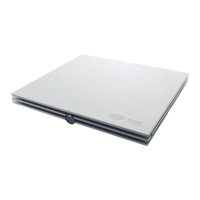Eclipse Additional Information Page 214
Q: Why 90Hz and 40Hz stimuli rate?
A: At repetition rates close to 40 stimuli/s, components of the middle latency response overlap and the
recorded ASSR is named the 40-Hz response (Galambos et al., 1981).
Although the ABR often can be identified in this response, it is dominated by evoked activity from the
higher auditory pathways in the thalamus middle brain and the cortex. The arousal state of the patient
must be awake to provoke the MLR and for awake children a 40Hz rate should be used when they are
10 years or older.
Previously studies for different ASSR test paradigms using stimulus rates around 90/s in order to eval-
uate the efficiency of a series of objective response detection algorithms, statistical test strategies and
novel stimuli (Stürzebecher et al., 2006).
The 90Hz stimuli rate is suitable for children (up to 9 years of age) and sleeping adults.
Q: At what age should the test be performed with the awake 40Hz stimuli rate?
A: According to a study of Nina Kraus and colleagues, detection of MLR components on children shows
similar values to adult (approaching 100% detectability) at approximately 10 years of age.
The study showed, no significant differences in the detectability of MLRs in males as compared to fe-
males, and there were no right vs. left ear differences. The strong age effect which appears to exist in
the MLR influences their clinical use. This indicates that when responses are present, they may be
useful indicators of hearing sensitivity, but the absence of MLRs in children cannot be taken as an indi-
cation of hearing loss. Similarly, absent or abnormal MLRs cannot be interpreted as a manifestation of
auditory pathway dysfunction, since there appears to be little difference in MLRs in normal subjects
and MLRs in patients with a wide range of neurologic, cognitive, and speech and language disorders
(Kraus et al.,1985).

